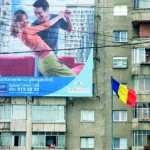In the early 1990s, the heritage contained in the communist neighborhoods was unbearable. It led to deep frustrations and neurosis due to their massiveness and complete absence of identity, but mostly by the general feeling that nothing could be done to change it.
The first reaction to that state of affairs in the town was compensated by the fantasy of the countryside ranch, the idyllic image intertwined with that of a swimming pool and the high wage that filled your fridge. Thus, it resulted in a true flight of the well off, less the middle class, almost inexistent at that time. At the level of motivation and reaction, this dwelling model is widely spread today.
Following the enthusiastic appearance of the first residential neighborhoods (Corbeanca, Pipera-Tunari, French Village), the first suburban green paradises, the cracks have appeared in the perfect dream: lousy infrastructure and facilities (streets, gas, water, electricity mains), waste of time in traffic, the 2004-2006 floods, boredom, monotony, routine, density and an ever greater lack of intimacy than in the socialist neighborhoods, the high costs of the daily life.
Seen from the perspective of this quietness, the town did no longer seem a place from which you had to escape. Thus, for some years now, the first “what if” have been uttered. What if we returned to town and reinvented the community spirit, to have neighbors again, and not waste our time on traffic, go to the movies, to a pub, and breathe in the general restlessness.
Where should you return to in town? After ten years, when for economic, logistic, financial power of investments and market capacity to buy, and the mentality reasons mentioned above, no building apartments where built, now they seem to move fast in search for new clients from the middle class. Well, there are many projects that grow into urban residential compounds, mainly, apartment buildings. They all promise something different from what we have experienced, lived, or seen so far. There are tenths of projects started in various parts of Bucharest. The first ones began in the northern part of the city, and then moved closer to the center and even there, or in the fringes of the socialist neighborhood. The place where you wished to run away from has become one for a better future.
Unfortunately, the chance of a new urbanity is not sustained by architectural or urban concepts. Except for some few cases, the architectural quality is modest: it extends the “block of flats”, socialist concept, or offers universal commercial by-products. Besides the in-fills from the existing street, the operations focus mostly on self-contained ensembles. Ironically, the modernist dream – prisms isolated in the middle of a park – is resorted to in the form of gated communities, protected enclaves, completely segregated from their context. Moreover, as it is now always the case of tall buildings in Romania, the location of the ensemble follows only the rules of the market, without being integrated into global planning. In fact, most terrains belong in the industrial disused areas for which no solution is considered so as to take advantage of this heritage.
Thus, unintentionally, with no support from local or central policies the return to the residential project of growing density in Bucharest seems to be a success private business story: the ten-floor apartment buildings, sold apartments in their project phase. For the moment, there are almost twenty projects of this kind, of which ten are big ensembles containing more than 300 apartments.
In the next two years, there are projects for 6 to 8,000 apartments, and in the next 5 years around 30,000. The long expected upgrading will be possible only if investments will be made in commercial centers, leisure or education facilities around these new ensembles, and when they are connected with their vicinities coherently. It is important that new focal points should be found along with the decentralization of the tradition center of Bucharest. We are going to see both the results and effects pretty soon.


